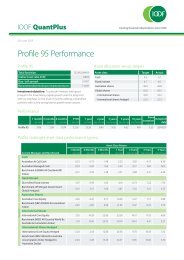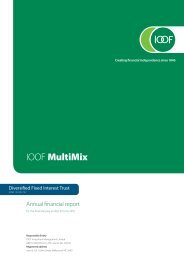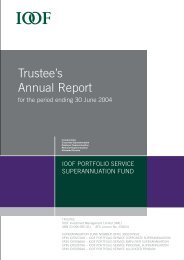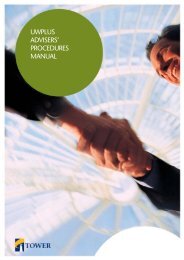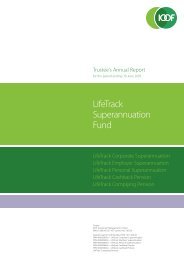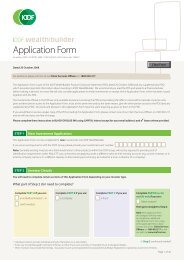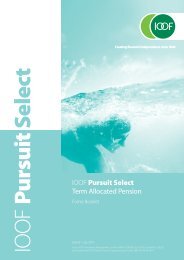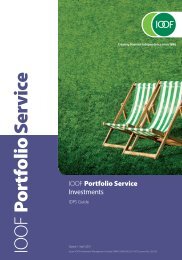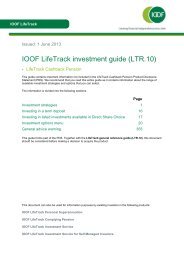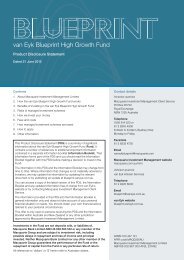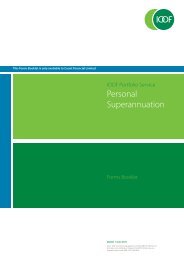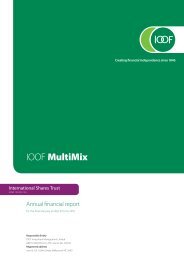annual report 2011
annual report 2011
annual report 2011
You also want an ePaper? Increase the reach of your titles
YUMPU automatically turns print PDFs into web optimized ePapers that Google loves.
IOOF | <strong>annual</strong> <strong>report</strong> <strong>2011</strong><br />
Notes to the financial statements (cont’d)<br />
For the year ended 30 June <strong>2011</strong><br />
(v) Share capital<br />
Ordinary shares<br />
Ordinary shares are classified as equity. Incremental costs<br />
directly attributable to the issue of new shares and share<br />
options are shown in equity as a deduction, net of any tax<br />
effects.<br />
Repurchase, disposal and reissue of share capital<br />
(treasury shares)<br />
When share capital recognised as equity is repurchased, the<br />
amount of the consideration paid, which includes directly<br />
attributable costs, net of any tax effects, is recognised as a<br />
deduction from equity. Repurchased shares are classified as<br />
treasury shares and are presented as a deduction from total<br />
equity. When treasury shares are sold or reissued subsequently,<br />
the amount received is recognised as an increase in equity, and<br />
the resulting surplus or deficit on the transaction is transferred<br />
to/from retained earnings.<br />
(e) Property and equipment<br />
(i)<br />
Recognition and measurement<br />
Property and equipment are measured at cost less any<br />
accumulated depreciation and any accumulated impairment<br />
losses.<br />
Cost includes expenditure that is directly attributable to the<br />
acquisition of the asset.<br />
The gain or loss on disposal of an item of property and<br />
equipment is determined by comparing the proceeds from<br />
disposal with the carrying amount of the property and<br />
equipment and is recognised net within other income/other<br />
expenses in profit or loss. When revalued assets are sold,<br />
any related amount included in the revaluation reserve is<br />
transferred to retained earnings.<br />
(ii)<br />
Subsequent costs<br />
Subsequent costs are included in the asset’s carrying amount<br />
or recognised as a separate asset, as appropriate, only when it<br />
is probable that future economic benefits associated with the<br />
item will flow to the Group and the cost of the item can be<br />
measured reliably. Repairs and maintenance costs are charged<br />
to profit or loss during the financial period in which they are<br />
incurred.<br />
(iii) Depreciation<br />
Depreciation is based on the cost of the asset less its residual<br />
value. Significant components of individual assets are assessed<br />
and if a component has a useful life that is different from<br />
the remainder of that asset, that component is depreciated<br />
separately.<br />
Depreciation is recognised in profit or loss on a straight-line<br />
basis over the estimated useful lives of each component<br />
of an item of property and equipment. Leased assets are<br />
depreciated over the shorter of the lease term and their useful<br />
lives unless it is reasonably certain that the Group will obtain<br />
ownership by the end of the lease term.<br />
The estimated useful lives for the current and comparative year<br />
are as follows:<br />
• office equipment 3-10 years<br />
• leasehold improvements 3-10 years<br />
• equipment under finance lease 3-10 years<br />
Depreciation methods, useful lives and residual values are<br />
reviewed at each <strong>report</strong>ing date, and adjusted if appropriate.<br />
(f)<br />
(i)<br />
Intangible assets<br />
Goodwill<br />
For the measurement of goodwill at initial recognition, see<br />
note 3(a)(i) Business combinations.<br />
Subsequent measurement<br />
Goodwill is measured at cost less accumulated impairment<br />
losses. In respect of equity-accounted investees, the carrying<br />
amount of goodwill is included in the carrying amount the<br />
investment, and impairment loss on such investment is not<br />
allocated to any asset, including goodwill, that forms part of<br />
the carrying amount of the equity accounted investee.<br />
(ii)<br />
Other intangible assets<br />
Other intangible assets that are acquired by the Group and<br />
have finite useful lives are measured at cost less accumulated<br />
amortisation and accumulated impairment losses.<br />
(iii) Subsequent expenditure<br />
Subsequent expenditure is capitalised only when it increases<br />
the future economic benefits embodied in the specific asset to<br />
which it relates. All other expenditure, including expenditure<br />
on internally generated goodwill and brands, is recognised in<br />
profit or loss as incurred.<br />
(iv) Amortisation<br />
Amortisation is based on the cost of an asset less its residual<br />
value.<br />
Amortisation is recognised in profit or loss on a straight-line<br />
basis over the estimated useful lives of intangible assets, other<br />
than goodwill, from the date that they are available for use.<br />
page 58



